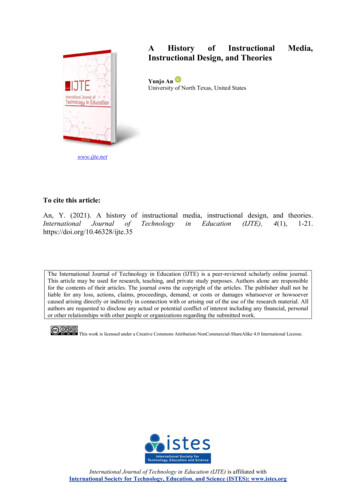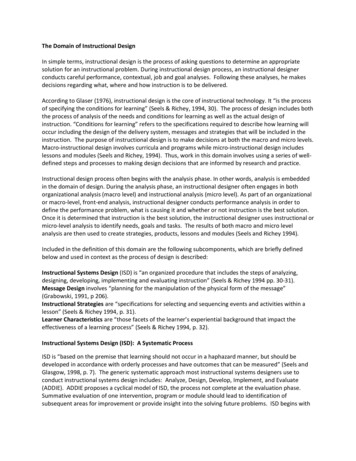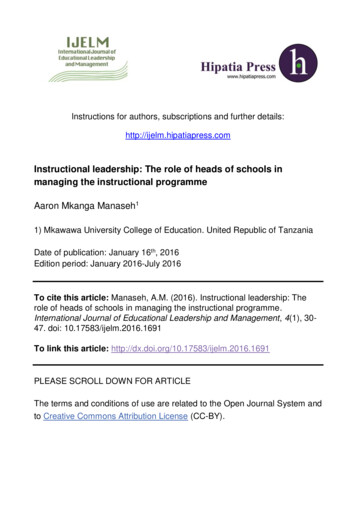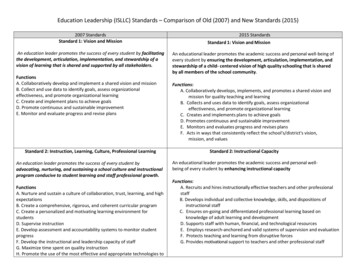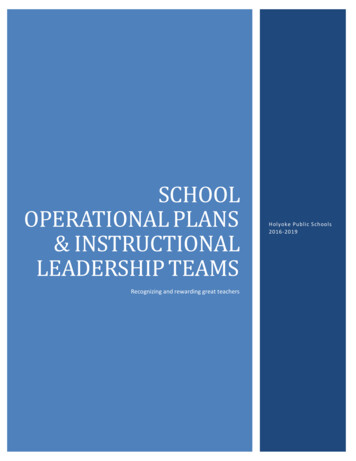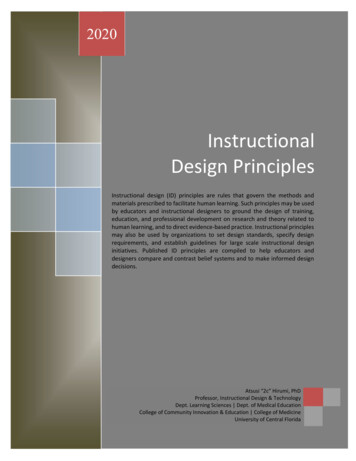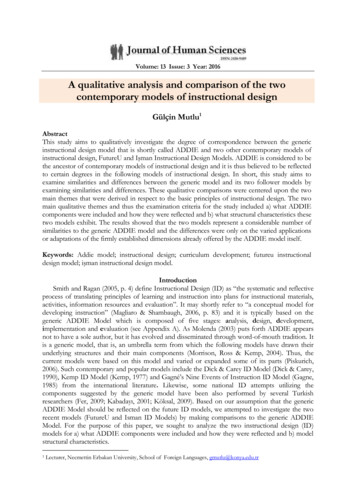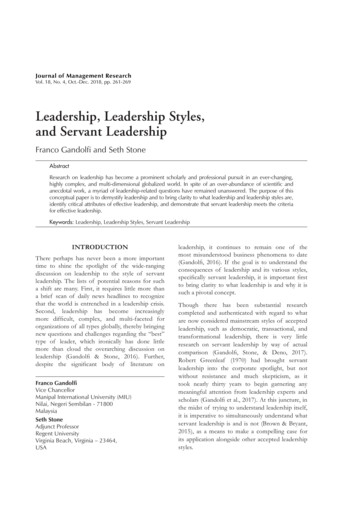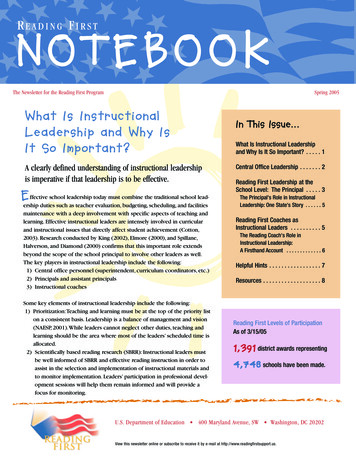
Transcription
READING FIRSTNOTEBOOKThe Newsletter for the Reading First ProgramSpring 2005What Is InstructionalLeadership and Why IsIt So Important?A clearly defined understanding of instructional leadershipis imperative if that leadership is to be effective.E ffective school leadership today must combine the traditional school leadership duties such as teacher evaluation, budgeting, scheduling, and facilitiesmaintenance with a deep involvement with specific aspects of teaching andlearning. Effective instructional leaders are intensely involved in curricularand instructional issues that directly affect student achievement (Cotton,2003). Research conducted by King (2002), Elmore (2000), and Spillane,Halverson, and Diamond (2000) confirms that this important role extendsbeyond the scope of the school principal to involve other leaders as well.The key players in instructional leadership include the following:1) Central office personnel (superintendent, curriculum coordinators, etc.)2) Principals and assistant principals3) Instructional coachesSome key elements of instructional leadership include the following:1) Prioritization:Teaching and learning must be at the top of the priority liston a consistent basis. Leadership is a balance of management and vision(NAESP, 2001).While leaders cannot neglect other duties, teaching andlearning should be the area where most of the leaders’ scheduled time isallocated.2) Scientifically based reading research (SBRR): Instructional leaders mustbe well informed of SBRR and effective reading instruction in order toassist in the selection and implementation of instructional materials andto monitor implementation. Leaders’ participation in professional development sessions will help them remain informed and will provide afocus for monitoring.In This Issue.What Is Instructional Leadershipand Why Is It So Important? . . . . . 1Central Office Leadership . . . . . . . 2Reading First Leadership at theSchool Level: The Principal . . . . . 3The Principal's Role in InstructionalLeadership: One State's Story . . . . . . 5Reading First Coaches asInstructional Leaders . . . . . . . . . . 5The Reading Coach's Role inInstructional Leadership:A Firsthand Account . . . . . . . . . . . . . 6Helpful Hints . . . . . . . . . . . . . . . . . 7Resources . . . . . . . . . . . . . . . . . . . 8Reading First Levels of ParticipationAs of 3/15/051,391 district awards representing4,748 schools have been made.U.S. Department of Education 400 Maryland Avenue, SW Washington, DC 20202View this newsletter online or subscribe to receive it by e-mail at http://www.readingfirstsupport.us.
3) Focus on alignment of curriculum, instruction, assessment, and standards: If student achievement is the goaland that goal is measured by standards-based assessments, the curriculum, instruction, and assessments allmust be aligned with the standards. If there is a disconnect among these elements, student achievement willnot be evident.Alignment is an ongoing process asstandards, curriculum, and assessments cycle throughimprovements.4) Data analysis: In their focus on improving achievement,effective leaders use multiple sources of information toassess performance (NAESP, 2001). Decisions at all levelsmust be based on pertinent data. Central office staff canuse data to help principals become more effective instructional leaders and to make decisions regarding policy andcurriculum. Principals can use data to help guide theinstructional focus and professional development of teachers. Coaches can use data to determine the effectivenessof instructional strategies. Coaches can also assist teachersin using data to establish student grouping arrangementsand pinpoint specific student intervention needs.5) Culture of continuous learning for adults: Effective instruction is a skill that can never be perfected.All teachers canbenefit from additional time and support to improve theirinstruction. Research indicates that effective principalshave “a view of instructional improvement as an ongoingprocess” (Chase & Kane, 1983). Leaders that maintainlearning as a priority will provide released time for teachers to attend relevant training.They will follow up bymonitoring and providing the support that sustains thenew learning.The expectations set by the leaders regarding priorities, SBRR,alignment, data use, and continued learning will impact classroom instruction and student achievement.The leaders at alllevels of the system have a clear and important role insupporting those improvement efforts.References:Chase, G., & Kane, M. (1983). The principal as instructional leader: How muchmore time before we act? Denver, CO: Education Commission of the States.Cotton, K. (2003). Principals and student achievement. Alexandria, VA:Association for Supervision and Curriculum Development.Elmore, R. (2000). Building a new structure for school leadership. Washington,DC: The Albert Shanker Institute.King, D. (2002). The changing shape of leadership. Educational Leadership,59(8), 61–63.National Association of Elementary School Principals, (2001). Leading learningcommunities: Standards for what principals should know and be able to do.Alexandria, VA: National Association of Elementary School Principals.Spillane, J., Halverson, R., & Diamond, J. (2000). Toward a theory of leadershippractice: A distributed perspective. Evanston, IL: Institute for Policy Research.Central Office LeadershipLeaders are expanding their traditional roles to include supportsfor improvements in teaching and learning.T he traditional roles of the central office leadership varywidely from policy implementation and monitoring to budgeting and public relations.As leaders at the central office levelmove toward a model of instructional leadership, their rolescan change dramatically.While traditional responsibilities stillmust be met, priorities should be shifting toward instructionalissues that will impact classroom instruction and studentachievement. Some of those elements include promoting avision; creating alignment of curriculum, instruction, assessment, and standards; focusing on data; and maintaining a culture of continuous learning (Lashway, 2002). By applying forand receiving a Reading First subgrant, a district has recognized the need to focus on instructional priorities and made a2U.S. Department of Educationcommitment to provide instructional leadership to itsparticipating schools to maximize the likelihood of theprogram’s success.The following vignette is a fictional account of what mighthappen, based on the strongest evidence of best practices,if ideal implementation of instructional leadership transpiresat the central office level.Instructional leaders at the Rising Star School District centraloffice have resolved that early literacy instruction will be adistrict priority. This district has applied for and received aReading First grant.The leaders know they are responsible for
creating vision and setting the tone for this change.Theyhave become champions for this important initiative.Theirvision and focus have set the priority for the leaders at theschool and classroom levels.The district’s curriculum director has a solid understanding of scientifically based readingresearch and effective reading instruction, and the leadershave a clear plan to provide training for other district leaderswhose work connects to the implementation of the grant.Whenever possible, they attend professional developmentsessions in which reading improvement is the focus.The central office leaders meet on a regular basis to share progressmade toward the goals outlined in their Reading First grant.They also ensure that competing initiatives do not interferewith the current focus of improvement.Rising Star’s central office content specialists have scheduledK–3 teacher teams to participate in alignment meetings.Atthese meetings, the teams review and analyze the scope andsequence of the curriculum as well as standards and benchmarks. Not only have the central office leaders put this valuable time aside to discuss these essential documents, but alsothey have preserved time in their schedules to personallyattend some meetings and monitor schools to ensure thealignment efforts are implemented.They also make themselves available to provide needed support.The district’s assessment specialist has helped develop aworkable districtwide assessment plan and schedule.Thisleader also provides guidance and assistance as schools selectand administer assessments that will measure and supportthe Reading First initiative.The assessment specialist providesthe district and schools with compiled assessment data in atimely fashion and in a usable and understandable formatthat will assist schools in making instructional decisions.The superintendent is well versed in Reading First requirements and the specifics of the district’s plan. He understandsthe importance of a culture of continuous learning. He offersschool principals the autonomy and flexibility to providetime for teachers to improve their practice.Additionally, hemonitors progress and implementation to ensure that thelearning the teachers participate in is directly connected tothe literacy initiative and directly transferred to classroominstruction.Rising Star is on the right track with a focused Reading Firstinitiative, systems to promote alignment, an effective data collection and dissemination procedure, a process to utilize datato continually refine instruction, and a culture of continuouslearning.All of these elements will sustain Rising Star’s effortto improve early literacy instruction.As more leaders adjust their roles to reflect the necessaryfocus on instructional improvements that will directly influence student achievement, so begins the process of systemicimprovements necessary for lasting change.References:Lashway, L. (2002). Developing instructional leaders (ERIC Digest No. 160). Eugene,OR: ERIC Clearinghouse on Educational Policy and Management. Retrieved January18, 2005, from ERIC database. (ERIC No. ED466023)Lewis, A. (1995). The anomaly of central office leadership [Electronic version].Believing in Ourselves: Progress and Struggle in Urban Middle School Reform. NewYork: The Edna McConnell Clark Foundation. Retrieved March 3, 2005, fromhttp://www.middleweb.com/BIOii9.htmlReading First Leadership at theSchool Level: The PrincipalPrincipals are a key element in school improvement efforts. The emphasison accountability, brought about by the passing of the No Child Left BehindAct, insists that school leaders not only implement effective programs butalso provide evidence of their success and justification for changes.A district’s Reading First grant is governed by the districtoffice staff but must be communicated and put into actionby the principals.These leaders have the responsibility toprioritize, align, assess, monitor, and learn in order to achieveimproved student outcomes.Reading First Notebook – Spring 20053
PrioritizeMonitorDecades of research confirm that those principals who placeacademics as a priority experience increased studentachievement (Bartell, 1990; Cotton, 2000; Johnson & Asera,1999; Short & Spencer, 1990). Principals typically have sufficient freedom to establish priorities within their schools.With instructional improvement at the top of that prioritizedlist, principals have the power to organize so that those mainconcerns, such as improved primary grade reading instruction, are addressed. Reading First principals can arrangeinstructional schedules, set aside time for grade-level teams tomeet, provide released time for teachers to attend professional development, and monitor progress and implementation toensure that scientifically based reading research (SBRR)strategies are being implemented schoolwide.These, alongwith other organizational measures, will send a messageabout what is important at the school.Monitoring is a crucial component of the principal’s responsibility. It will ensure that the school’s Reading First programis implemented with fidelity and that any instructionalchanges indicated by the data and expected by the principalactually occur. Once data are analyzed and the school staffunderstands what implications the data have for instruction,instructional decisions are made.The principal follows up byasking questions, visiting classrooms, and reviewing subsequent data to guarantee instructional changes are occurringand progress is being made. Principals should follow theadvice of the old adage,“Don’t expect what you don’tinspect.” If instructional changes are not inspected, leadersshould not expect improvements.AlignAlignment is a broad issue that a principal has the obligationto understand and address. Principals must impart uponteachers the importance of aligning curriculum, instruction,and assessment to the standards.The principal must alsoguide teachers in effective alignment practices. Study groupsor departmental meetings can be established with the expectation that teachers will work together to interpret the standards, study the scope and sequence of the curriculum, shareeffective instructional strategies, examine released assessmentitems, and analyze student work to determine instructionaleffectiveness.These activities will help ensure alignment andstrengthen the Reading First program.AssessThe principal plays a key role in selection of schoolwideassessment instruments following the guidelines outlined byReading First.The administration, scoring, reporting, andappropriate use of assessment data should be stressed by theschool leader as a critical element of increased studentachievement. Principals should regularly analyze studentachievement data to inform decisions regarding policy, programs, and professional development.Teachers may needguidance to effectively administer, score, interpret, and analyze the data and also to utilize the data in making instructional changes.The principal is responsible for ensuring thatthe teachers receive the guidance they require.4U.S. Department of EducationLearnAs the school leader works to improve student achievement,the principal collaborates with teachers on alignment,instruction, and assessment issues; provides released time forteachers to attend Reading First professional developmentsessions; and offers constructive feedback and support.Principals have an obligation to be well informed about theprofessional development teachers are receiving. Providingteachers time for professional growth and personally attending those professional development sessions reinforces theprincipal’s conviction in the positive aspects of a continuouslearning environment.Effective principals are adept at prioritizing, informed aboutalignment issues, knowledgeable about assessments, and supportive of participants’ collaborative efforts to learn andimprove.They are the leaders who will open the door toschool improvement and increased student achievement.References:Bartell, C. A. (1990). Outstanding secondary principals reflect on instructionalleadership. The High School Journal, 73(2), 118–128.Cotton, K. (2000). The schooling practices that matter most. Alexandria, VA:Association for Supervision and Curriculum Development.Johnson, J. F., & Asera, R. (1999). Hope for urban education: A study of ninehigh-performing, high-poverty, urban elementary schools. Austin, TX: Charles A.Dana Center, University of Texas. Retrieved March 3, 2005, fromhttp://www.ed.gov/pubs/urbanhope/Short, P. M., & Spencer, W. A. (1990, Winter). Principal instructional leadership.Journal of Research and Development in Education, 23(2), 117–122.
The Principal’s Role in Instructional LeadershipOne State’s StoryThere can be many obstacles that principals must overcome inorder to lead an effective Reading First program in their schools.Typical obstacles include teacher resistance to change, districtwide directives that are not aligned with Reading First, andspecific state reading initiatives that are not based on scientifically based reading research. Former Reading First director atthe Idaho Department of Education Marybeth Flachbart reportsthat schools with identical curricular programs, similar grantamounts, and comparable student populations can varydramatically when it comes to student achievement. Thedifference, as she sees it, is the strength of the principal’sleadership skills. Strong instructional leadership may be thekey to managing the obstacles that may hinder the success ofa Reading First program.Idaho’s Reading First program offers principals many opportunities to grow as instructional leaders. Four 1-day meetings arescheduled per school year for principals to attend leadershipacademies. There they learn the fundamentals of early readinginstruction, monitoring techniques, and strategies to implementdifferentiated instruction. They also dialogue with their peersand visit nearby schools that are employing the same core curriculum to observe and discuss implementation issues withother principals. Principals are required to attend all ReadingFirst staff development meetings so that they are aware of, andcan monitor, what teachers and coaches are being asked to do.Principals are encouraged to work closely with central officestaff to make certain that competing initiatives don’t underminethe goals of Reading First.Collaboration among leaders, the autonomy to adapt district policy to align with the needs of Reading First, and the networkingand learning opportunities of the leadership academies are afew of the ways Idaho is increasing the instructional leadershipof its Reading First principals.To learn more about Idaho’s Reading First program, go /.Reading First Coaches asInstructional LeadersInstructional coaching is one of the key elements of an effective ReadingFirst program. Coaches provide instructional support, from goal setting toteacher support and mentoring; assessment expertise; and professionaldevelopment on topics such as effective instructional strategies, currentresearch, and using data to inform instruction.The training that coaches receive should go above andbeyond the training that teachers implementing ReadingFirst receive.This intense training in leadership, assessment,and professional development will help establish the coachas a competent expert who works collaboratively withteachers to develop effective lessons designed to improvestudent outcomes.The Coach as Instructional LeaderThe Reading First coach assists K–3 teachers in the effectiveimplementation of their reading program.This may includeassisting teachers in setting goals, organizing a workableschedule, observing instruction, demonstrating effective lessons, providing constructive feedback, and serving as aresource for effective instructional strategies and interventions.The coach must have clearly defined responsibilitiesand scheduled time to accomplish those duties.The coach’stime should not be consumed with clerical, fund raising,substitute teaching, or tutorial responsibilities that are unrelated to or not stipulated in the Reading First grant.Reading First Notebook – Spring 20055
The Coach as Assessment ExpertThe Reading First coach must have a solid understanding ofthe screening, diagnostic, progress monitoring, and outcomesassessments.The coach is responsible for guiding the use ofand ensuring the proper implementation of these assessments.The coach reviews this data with grade-level teams anddiscusses student, classroom, and grade-level issues that arisefrom this analysis.The coach shares the data with the principal, and they work together to make adjustments to ensuregoal achievements.The coach also uses assessment data toplan necessary professional development for teachers.The Coach as ProfessionalDevelopment ProviderReading First, including scientifically based reading research,assessment issues, effective instructional strategies, use ofthe core reading program, and intervention concerns.TheReading First coach should also strive to remain current onreading issues by attending professional development andreading current research. Sometimes, the coach best servesthe teachers by recognizing when outside expertise is needed and securing that assistance.Coaching is a significant responsibility.The success of thecoach has considerable bearing on the effectiveness of aschool’s implementation of Reading First. Coaching can be achallenging yet rewarding experience.It is the coach who is primarily responsible for developingteachers’ knowledge and skills as they relate to the goals ofThe Reading Coach’s Role in InstructionalLeadership A Firsthand AccountBy Kathleen TheodoreInstructional coaching is a promising model for teacher development intended to improve teaching and learning (Joyce &Showers, 1988; Lyons & Pinnell, 2001; Neufeld & Roper, 2003;Symonds, 2003). Coaches model and observe lessons andreflect with teachers in order to build instructional capacity.Coaching provides job-embedded professional developmentcombined with reflective and collaborative work among professionals that sustains professional learning. It could be saidthat coaches serve as a teacher’s safety net.Although reading coaches perform a variety of activities,I have learned that in-class coaching is the most powerfuland has great potential to impact classroom instruction.However, the coach’s close involvement in the teacher’sotherwise isolated world may create anxiety among teachers.That anxiety is often so great that it translates to a strongresistance to change.I explored the coaching model while guiding reading coacheswho worked directly with classroom teachers in the Orleansand Jefferson Parish School Districts in southeasternLouisiana. The biggest challenge in coaching, in my experience, is teacher anxiety and resistance to change. Suchresistance can be very difficult to overcome. However, as Ivisited classrooms, it was clear to me that the coaches withwhom I was working had something special going on. There6U.S. Department of Educationwas mutual respect, trust, and collaboration between coachand teacher.What seems to lead to this collegial partnership? Each coachhad formulated a unique style of in-class coaching. Thoughthe styles varied from coach to coach, they all consisted ofmodeling and demonstrating lessons for several weeks. Whencoaches modeled and demonstrated with the teacher’s ownstudents, they provided teachers with the technical supportthey needed. The teacher was able to view an effective lesson that succinctly spotlighted a specific objective, and students were eagerly engaged. The teacher and coach thenreflected on the lesson and discussed both its successfulaspects and areas that needed further development. This provided an invitation for the teacher to be open to improvement.Through a delicate dance of pressure and support, teachersexperienced success. Teachers were mandated to followrules and expectations for participating in the apprenticeship.Rules ranged from attending and observing demonstrationlessons to participating in follow-up discussions and reflection to modeling and demonstrating in the presence of thereading coach.The coaches also provided ample support to the teachers.Teachers were assigned parts of a demonstrated lesson to
practice on their own as well as with the reading coach.Chunking the lesson into manageable parts allowed teachersmore guidance and created a way for the coach to provideimmediate corrective feedback. This cyclical sequence ofmodeling, teaching, and practicing allowed teachers theopportunity to gain automaticity with effective reading strategies and instruction. Teachers felt empowered from their newdiscoveries as test scores and reading achievement increased.There are some lessons to be learned. Teachers often needpressure and support in order to overcome their anxietytoward and resistance to a new type of reading instruction. Tohelp teachers overcome this, we need to create the sameenvironment that we want for our students, that is, one that isnonthreatening with the freedom to make mistakes. Creatingthis kind of safety net will help ensure that teachers improvetheir skills in implementing effective reading practices. In thisway, all students may reach grade-level reading achievement.References:Joyce, B., & Showers, B. (1988). Student achievement through staffdevelopment. White Plains, NY: Longman.Lyons, C., & Pinnell, G. (2001). Systems for change in literacy education:A guide to professional development. Portsmouth, NH: Heinemann.Neufeld, B., & Roper, D. (2003). Coaching: A strategy for developing instructional capacity. Washingon, DC: The Aspen Institute Program on Educationand the Annenberg Institute for School Reform.Symonds, K. W. (2003). Literacy coaching: How school districts can supporta long-term strategy in a short-term world. San Francisco: Bay AreaSchool Reform Collaborative.Helpful HintsDealing With Teachers and ChangeTeachers often find change difficult. Researchers have suggested various reasons for teachers’ resistance to change, includinga lack of congruency between the teacher’s educational philosophy and the innovation (Briscoe, 1991; Rich, 1990); lack of adequate training and/or support (Joyce & Showers, 1988;Mathison, 1992); school climate and principal influence (Fullan &Hargreaves, 1997); and practical issues such as availability ofmaterials, class size, and time (Sleeter, 1992). Despite thesepossible causal indications, there are steps that can be taken toresolve some of the resistance issues.Teachers want their students to succeed, and given the propertraining and support, they are willing to do what is necessary toimprove student achievement. The coaching aspect of ReadingFirst offers teachers the in-class support and guidance theyneed as they begin the implementation of a new program or areasked to refine their instructional delivery. Teachers are morelikely to consistently use an instructional strategy once theyhave evidence of its effectiveness with students (Guskey, 1985,1986, 1989). One of Reading First’s goals is to move teachersaway from relying on their personal philosophies when it comesto selecting instructional strategies and resources and towardrelying on evidence-based practices. A coach can demonstrateappropriate implementation of the strategy and provide theencouragement teachers need to stick with the strategy longenough to judge its effectiveness.School leaders—the principal and the coach—can provideteachers with regular feedback on student progress. Sincechanges that last depend on the effectiveness of their efforts,teachers need tangible evidence that students are growing andimproving. Assessment results and observation feedback are justtwo ways that teachers can be informed of progress being made.Support coupled with pressure is essential for continuing educational improvements (Guskey, 2002). Support allows teachersdealing with anxiety and possible failures to cope more easily,while pressure is sometimes necessary to motivate those lesswilling to change. Leaders play a key role in assisting andencouraging teachers to make the sustained changes necessaryfor increased student achievement.References:Briscoe, C. (1991). The dynamic interactions among beliefs, role metaphors,and teaching practices: A case study of teacher change. Science Education,75(2), 185–199.Fullan, M., & Hargreaves, A. (1997). What’s worth fighting for in your school?(2nd. Ed.). New York: Teachers College Press.Guskey, T. R. (1985). Staff development and teacher change. EducationalLeadership, 42(7), 57–60.Guskey, T. R. (1986). Staff development and the process of teacher change.Educational Researcher, 15(5), 5–12.Guskey T. R. (1989). Attitude and perceptual change in teachers. InternationalJournal of Educational Research, 13(4), 439–453.Guskey, T. R. (2002). Professional development and teacher change. Teachersand Teaching: Theory and Practice, 8(3/4), 381–391.Joyce, B., & Showers, B. (1988). Student achievement through staffdevelopment. New York: Longman.Mathison, S. (1992). An evaluation model for inservice teacher education.Evaluation and Program Planning, 15(3), 255–261.Rich, Y. (1990). Ideological impediments to instructional innovations: The caseof cooperative learning. Teaching and Teacher Education, 6(1), 81–91.Ross, J. (1994). The impact of an in-service to promote cooperative learningon the stability of teacher efficacy. Teacher and Teacher Education, 10(4),381–394.Sleeter, C. (1992). Restructuring schools for multicultural education. Journal ofTeacher Education, 43(2), 141–148.Reading First Notebook – Spring 20057
ResourcesLeading for Reading Success: AnIntroductory Guide for Reading FirstCoaches is a product of the National Centerfor Reading First Technical Assistance and wasdeveloped by the Central Regional ReadingFirst Technical Assistance Center, located at theUniversity of Texas at Austin.This module is designed to provide professional development to Reading First coaches andother instructional leaders who work directlywith Reading First schools and teachers. Itpresents key information to enhance coaches’knowledge and expertise as they take the leadtoward improving classroom reading instruction and, ultimately, student outcomes inreading.Center has a number of Reading Firstresources available on its Web site (www.calread.net). The site describes its technicalassistance services, outlines the center’steacher and principal trainings, and presentsdetailed descriptions of its professional development offerings to Reading First coaches(including training module overviews). There isalso a section describing skills assessmentinformation. A helpful list of resources, including training and special topic videos producedby the center, pacing schedules, and researchrelevant to Reading First, is available as well.All information is specific to either theHoughton-Mifflin Reading program or the SRAOpen Court Reading program, depending onwhich p
King,D. (2002).The changing shape of leadership.Educational Leadership, 59(8),61-63. National Association of Elementary School Principals,(2001).Leading learning communities: Standards for what principals should know and be able to do. Alexandria,VA: National Association of Elementary School Principals.
